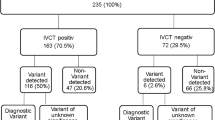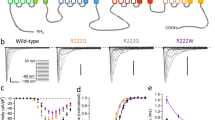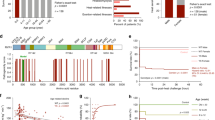Abstract
Central core disease (CCD) of muscle is an inherited myopathy which is closely associated with malignant hyperthermia (MH) in humans. CCD has recently been shown to be tightly linked to the ryanodine receptor gene (RYR1) and mutations in this gene are known to be present in MH. Mutation screening of RYR1 has led to the identification of two previously undescribed mutations in different CCD pedigrees. One of these mutations was also detected in an unrelated MH pedigree whose members are asymptomatic of CCD. The data suggest a model to explain how a single mutation may result in two apparently distinct clinical phenotypes.
This is a preview of subscription content, access via your institution
Access options
Subscribe to this journal
Receive 12 print issues and online access
$209.00 per year
only $17.42 per issue
Buy this article
- Purchase on Springer Link
- Instant access to full article PDF
Prices may be subject to local taxes which are calculated during checkout
Similar content being viewed by others
References
Shy, G.M. & Magee, K.R. A new congenital non-progressive myopathy. Brain 79, 610–21 (1956).
Dubowitz, V. & Roy, S. Central core disease in muscle: clinical, histochemical and electron microscopic studies of an affected mother and child. Brain 93, 138–146 (1970).
Isaacs, H., Heffron, J.J.A. & Badenhorst, M. Central core disease: A correlated genetic, physiochemical, ultramicroscopic and biochemical study. J. Neurosurg. Psychiatry 38, 1177–1186 (1975).
Eng, G.D., Epstein, B.S., Engel, W.K., McKay, D.W. & McKay, R. Malignant hyperthermia and central core disease in a child with congenital dislocating hips: Case presentation and review. Arch. Neurol. 35, 189–97 (1978).
Byrne, E., Blumbergs, P.C. & Hallpike, J.F. Central core disease: study of a family with five affected generations. J. neurol. Sci. 53, 77–83 (1982).
Dubowitz, V. & Brooke, M.H. Muscle biopsy: a modern approach. in Major Problems in Neurology (ed. Walton, J.N.) 92–119 (Saunders, London, 1973).
Carpenter, S. & Karpati, G. . in Pathology of Skeletal Muscle 434–441 (Churchill Livingstone, New York, 1984).
Hayashi, K., Miller, R.G. & Brownell, A.K.W. Central core disease: ultrastructure of the sacroplasmic reticulum and t-tubules. Muscle Nerve 12, 95–102 (1989).
Denborough, M.A., Dennett, X. & Anderson, R.M. Central core disease and malignant hyperthermia. Br. med. J. 1, 272–276 (1973).
Shuaib, A., Paasuke, R.T. & Brownell, A.K.W. Central core disease: clinical features in 13 patients. Medicine 66, 389–396 (1987).
Krivosic-Horber, R. & Krivosic, I. Central core disease associated with malignant hyperthermia sensitivity. Presse Med. 18, 828–831 (1989).
Britt, B.A. Dantrolene-an update in Malignant hyperthermia (ed. Britt, B.A.) 325–367 (Martinus-Nijhoff, Amsterdam, 1987).
Gronert, G.A. Malignant hyperthermia in Myology Vol. 2 (eds Engel, A.G. & Banker, B.Q.) 1763–1784 (McGraw-Hill, New York, 1986).
Ellis, F.R. & Heffron, J.J.A. Clinical and biochemical aspects of malignant hyperthermia. in Recent Advances in Anaesthesia and Analgesia (eds Atkinson, R. S. & Adams, A.P.) 15, 173–207 (Churchill-Livingstone, New York, 1985).
European Malignant Hyperthermia Group. A protocol for investigation of malignant hyperpyrexia susceptibility. Br. J. Anaesth. 56, 1267–71 (1984).
MacLennan, D.H. & Phillips, M.S. Malignant hyperthermia. Science 256, 789–794 (1992).
MacKenzie, A.E. et al. The human ryanodine receptor gene: its mapping to 19q13.1, placement in a chromosome 19 linkage group, and exclusion as the gene causing myotonic dystrophy. Am. J. hum. Genet. 46, 1082–89 (1990).
Fujii, J. et al. Identification of a mutation in porcine ryanodine receptor associated with malignant hyperthermia. Science 253, 448–451 (1991).
Gillard, E.F. et al. A substitution of cysteine for arginine 614 in the ryanodine receptor is potentially causative of human malignant hyperthermia. Genomics 11, 751–755 (1991).
Schulman, S.R. The Sixth International Malignant Hyperthermia Workshop. Anesthesiology 78, 626 (1993).
Gillard, E. et al. Polymorphisms and deduced amino acid substitutions in the coding sequence of the ryanodine receptor (RyR1) gene in individuals with malignant hyperthermia. Genomics 13, 1247–1254 (1992).
Levitt, R.C. et al. Evidence for genetic heterogeneity in malignant hyperthermia susceptibility. Genomics 11, 543–547 (1991).
Deufel, T. et al. Evidence for genetic heterogeneity of malignant hyperthermia susceptibility. Am. J. hum. Genet. 50, 1153–1161 (1992).
Levitt, R.C. et al. Evidence for the localisation of a malignant hyperthermia susceptibility locus (MHS2) to human chromosome 17q. Genomics 14, 562–566 (1992).
Haan, E.A., Freemantle, C.J., McCure, J.A., Friend, K.L. & Mulley, J.C. Assignment of the gene for central core disease to human chromosome 19. Hum. Genet. 86, 187–190 (1990).
Kausch, K. et al. Evidence for linkage of the central core disease locus to the proximal long arm of human chromosome 19. Genomics 10, 765–769 (1991).
Mulley, J.C. et al. Refined genetic localization for central core disease. Am. J. hum. Genet. 52, 398–405 (1993).
Orita, M., Suzuki, Y., Sekiya, T. & Hayashi, K. Rapid and Sensitive Detection of point mutations and DNA polymorphisms using the polymerase chain reaction. Genomics 5, 874–879 (1989).
Zorzato, F. et al. Molecular cloning of cDNA encoding the human and rabbit forms of the Ca2+ release channel (ryanodine receptor) of sarcolplasmic reticulum. J. biol. Chem. 265, 2244–2256 (1990).
Otsu, K. et al. Molecular cloning of cDNA encoding the Ca2+ release channel (ryanodine receptor) of rabbit cardiac muscle sarcolplasmic reticulum. J. biol. Chem. 265, 13472–13483 (1990).
Hakamata, Y., Nakai, J., Takeshima, H. & Imoto, K. Primary structure and distribution of a novel ryanodine receptor/calcium release channel from rabbit brain. FEBS Lett. 312, 229–235 (1992).
Morgan-Hughes, J.A., Brett, E.M., Lake, B.D. & Tome, F.M.S. Central core disease or not? observations on a family with a non-progressive myopathy. Brain 96, 527–535 (1973).
Palmucci, L., Schiffer, D., Monga, G., Mollo, F. & de Marchi, M. Central core disease: histochemical and ultrastructural study of muscle biopsies of father and daughter. J. Neurol. 218, 55–61 (1978).
Old, J.M. & Higgs, D.R. . in Methods in Haematology (ed. Weatherall, D.) 74 (Churchill-Livingstone, Edinburgh, 1983).
Chomczynski, P. & Sacchi, N. Single step method of RNA isolation by acid guanidinium thiocyanate-phenol-chloroform extraction. Anal. Biochem. 162, 156–159 (1987).
Gyllensten, U.B. & Erlich, H.A. Generation of single-stranded DNA by the polymerase chain reaction and its application to direct sequencing of the HLA-DQR locus. Proc. natn. Acad. Sci. U.S.A. 85, 7652–7656 (1988).
Zhang, W., Hu, G. & Deisseroth, A. Improvement of PCR sequencing by formamide. Nucl. Acids Res. 19, 6649 (1991).
Author information
Authors and Affiliations
Rights and permissions
About this article
Cite this article
Quane, K., Healy, J., Keating, K. et al. Mutations in the ryanodine receptor gene in central core disease and malignant hyperthermia. Nat Genet 5, 51–55 (1993). https://doi.org/10.1038/ng0993-51
Received:
Accepted:
Issue Date:
DOI: https://doi.org/10.1038/ng0993-51
This article is cited by
-
A review of major causative genes in congenital myopathies
Journal of Human Genetics (2023)
-
Expanding the clinical-pathological and genetic spectrum of RYR1-related congenital myopathies with cores and minicores: an Italian population study
Acta Neuropathologica Communications (2022)
-
Pathological conformations of disease mutant Ryanodine Receptors revealed by cryo-EM
Nature Communications (2021)
-
Molecular and cellular basis of genetically inherited skeletal muscle disorders
Nature Reviews Molecular Cell Biology (2021)
-
A recurrent RYR1 mutation associated with early-onset hypotonia and benign disease course
Acta Neuropathologica Communications (2021)



